
The new pond, finished on 26 April 2009: now I'm just waiting for the rain to finish filling it
This is the full story, in pictures, of the making of my new wildlife garden pond.
I’ve tried to bring together a design which takes account of the many myths that exist about ponds and which have come to dominate garden pond design.
What makes a good wildlife pond is:
– really clean water: this is the most important thing you can do for a wildlife pond.
– plenty of shallow areas: and shallow means less than 5 cm.
– edges as natural as possible: in a garden in practice this means grassy, very gently shelving, and gently varying in depth.
Most advice about garden ponds barely mentions these things. The reason: almost nothing is known about what really makes garden ponds tick. So writers, who abhor an intellectual vacuum, simply make stuff up! Amazingly.
The advice here is based on Pond Conservation’s work on ponds out in the countryside – but even we don’t yet know much about real garden ponds. But we’re learning fast, and the advice below is putting what we do know into practice.
UPDATE: As the pond develops I’ll also be trying to make it look as attractive as possible as well.
Anyway, back to the beginning: the 1st of March 2009 to be exact.
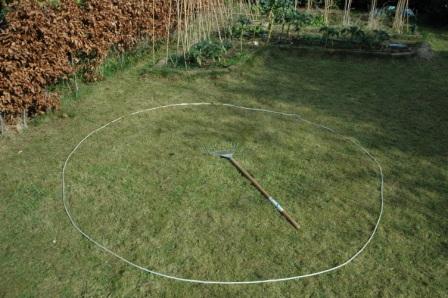
The first cut. I marked the site out with a rope. You can use a hosepipe, string between sticks, bamboo canes – whatever suits you.
For wildlife, the pond shape is less important than the depth (you need lots of shallow water) and the how clean the water is, and what the edges are like.
So ‘natural or ‘formal’: it depends on what looks good in your garden.
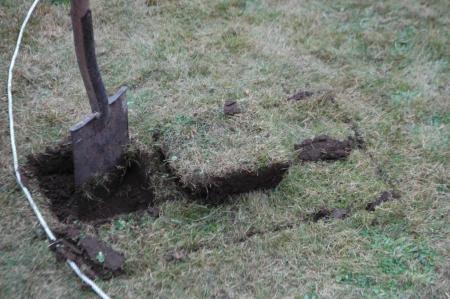
Remove the turves: you won’t be needing them again. Don’t put them in the pond! They will almost certainly add a massive blast of polluting nutrients to the water which will plague you for the rest of the pond’s life.
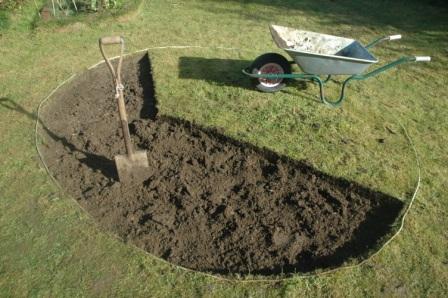
It doesn’t matter when you start or when you finish. I started in March because I had the time then – too late for breeding frogs this year but in time for the main period of warm weather when all kinds of bugs, beetles, mayflies, dragonflies and all the other things are flying about to colonise the pond.

I did a couple of hours digging each time.
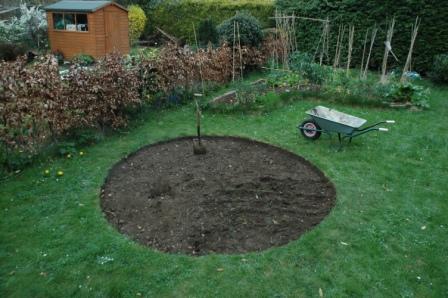
By the 11th April I had all the turves stripped off. This took me about 6 hours all together – its slower if you don’t do it all at once. Probably I could have got this far in a long afternoon.
I was fairly confident that the site was more or less level – now it was time to check more carefully.
I needed a piece of wood more than 3 m long to go right across the pond. I didn’t have one at home so had to buy a piece from the local timber merchants for a fiver. I expect you could scrounge something like this for free.
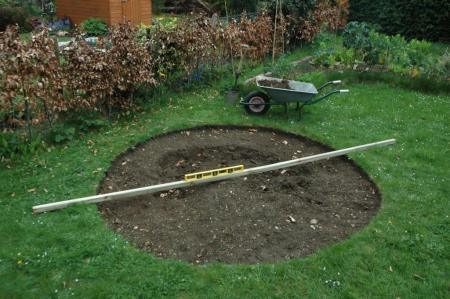
With the spirit level laid on the wood, I could see that the pond was a little bit higher at the back, the side away from the camera.
It wasn’t too much but did mean a bit of fine tuning was needed at the end.
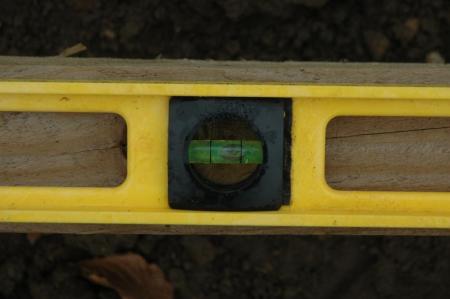
The bubble should be between the two lines
Its very easy to dig a wildlife pond too deep and end up with one of those things that looks a like a miniature version of a giant open cast mine.
A wildlife pond should have lots of shallow water – mine is roughly 50% shallows, and the deep area is not more than 30 cm.
The standard advice that you need to dig down to 50 cm or 60 cm of whatever the writer thinks applies only to fish ponds. The reason you’re told to do this – the pond might freeze solid – might apply in northern Canada, but is simple nonsense in England. The other reason – that oxygen may run out – is probably true sometimes but is not a cast iron rule.
Those of you who read the blog will know that in my first shallow pond oxygen levels rose during the ice cover this winter to double the normal value.
The other problem with digging down this deep in a small pond is that you end up with very steep, or vertical, edges. I’ve managed to get away with having only one ‘cliff’, between the shallow basin and the deep area.
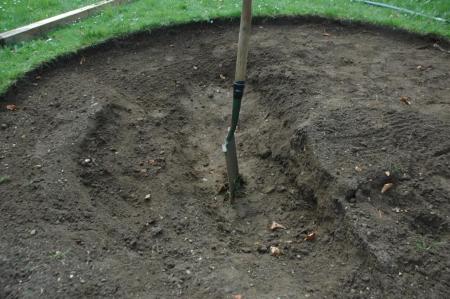
The maximum depth is not much more than 1 spade deep
Update 2 May 2009. Just saw this comment on a wildlife pond making website:
‘To assist with water clarity, make your pond as big as possible and avoid a deeply shaded site‘.
There’s no reason to think that either the size or the amount of shade will have anything to do with how clear the water is.
In fact, shaded ponds ae more likely to be clear (less light for algal growth); size really makes no difference.
Anyway, getting back to story, at this point I realised I had a big problem with the edges.
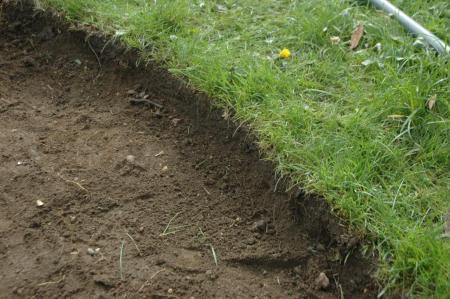
Just in the simple act of removing the turves I’d created a massive steep cliff right at the edge of the pond: the place I was trying to get the gentlest slope.
This happened because its very difficult to dig a turf out that isn’t this 4″ (10 cm) deep because its where the grass roots down to.
There are probably a variety of solutions to this problem.
I chose to raise the turf, remove roughly half the soil from each turf making it half the thickness, and place the spare soil in from the of the turf so making the slope from pond to grass a bit gentler. I don’t think its the ideal solution but it was fairly quick to do.
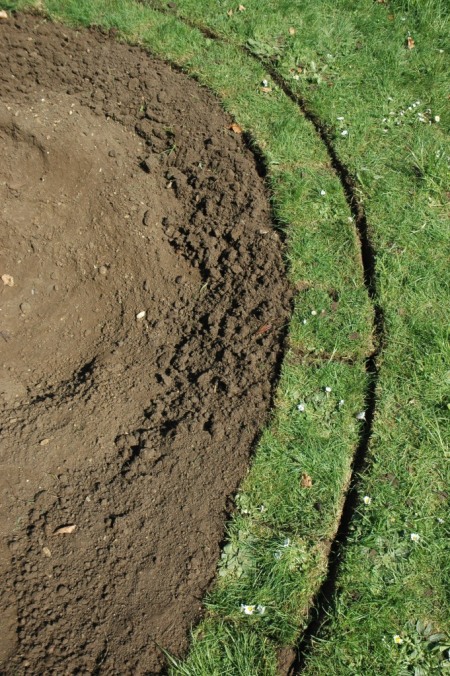
Now the pond bottom will be at the same level as the bottom of the turf at the edge of the pond.
But the real way to get shallow water in a small pond is have shallow basins.
So this is the final shape: in large parts of the pond, it hardly looks as though I’ve done any digging at all. This is the right depth for pond wildlife.
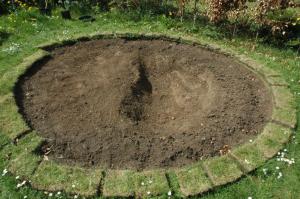
Tadpoles love shallows: its where they spend a lot of time in my first pond.
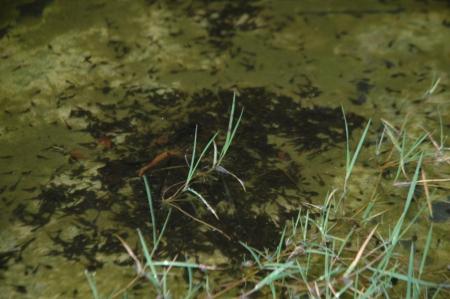
Here are my taddies congregating in the shallow warm water they love. This is right in the middle of my first pond: normally the deepest area, in my pond its the exact opposite way round. The middle of the pond is the shallowest area, so shallow it will dry out in the warmer weather. But now its great for the baby frogs, and by the time it dries, they'll probably have grown up and left the pond
Almost all other pond wildlife is happiest in very shallow water as well.
Most garden ponds are too deep for their area: if you want a half metre deep pond, or deeper, it needs to be much bigger or you end up with very steep sides.
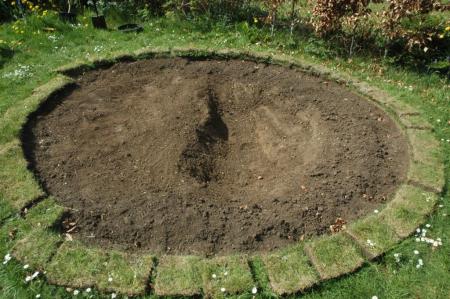
The really final shape with turves cut and arranged to cover the liner
The really striking thing about the final shape is just how shallow the pond is: I’m pretty pleased with this, although there’s room for improvement around the edges.
Now the lining: I opted to buy the underlay just for speed – I didn’t have any old carpet around so simply put down a double thick layer of the underlay on sale at the garden centre.
I did remove the stones fairly carefully, but I didn’t bother with sand.
As the total bill for liner and underlay was £134, and as I will have hours of pleasure from the pond for nothing apart from this, I didn’t mind the expense. The liner itself was £90.30. But the resourceful could do it for less.
This is the same approach as I took on the first pond (except there I had a left over roll of underlay I could use from the previous owners of the house).
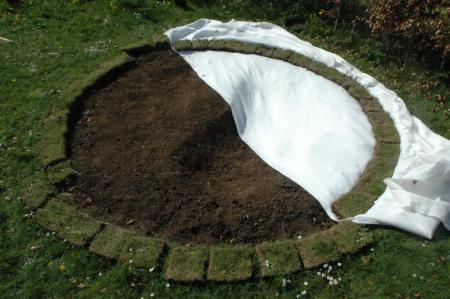
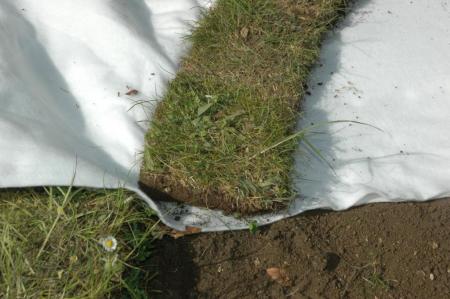
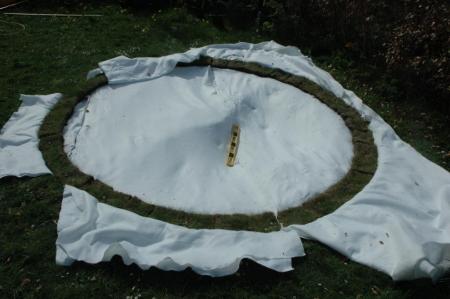
And then suddenly we’re nearly done: put the liner over the top and add some water to hold it down.
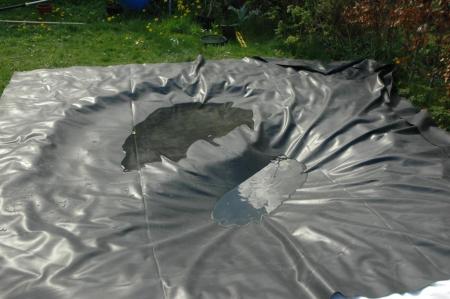
Notice – no hoses. My tapwater is not fit to use in a pond – full of nutrients. In some parts of the country (in the north, for example) its OK where its come off the moors. Down south, its mostly not fit to use in a pond. In most parts of England you can check on the water companies website whether your drinking water is fit to go in a pond – in about half the country it isn’t.
From here on in we have a pond!
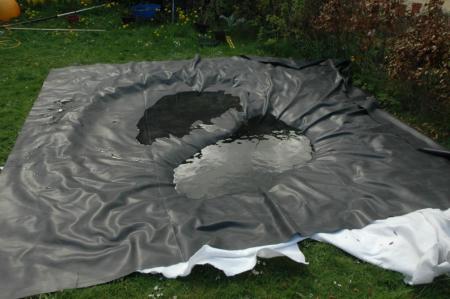
Now you begin to see the two halves of the pond.
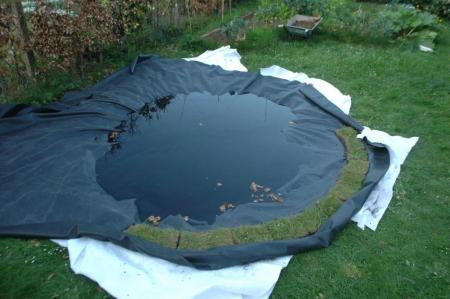
Now it’s just a case of finishing putting the turves in place, and trimming the liner and underlay.
I didn’t quite have enough water in my water butts to fill the pond completely so now we need to pray for rain – luckily it came the next day.
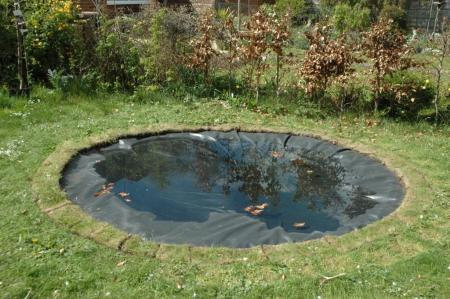
Everything trimmed up, and the turves all in place. There’s even the first leaves falling in the pond: leaves are a great source of food, shelter and building materials for pond animals.
And finally:
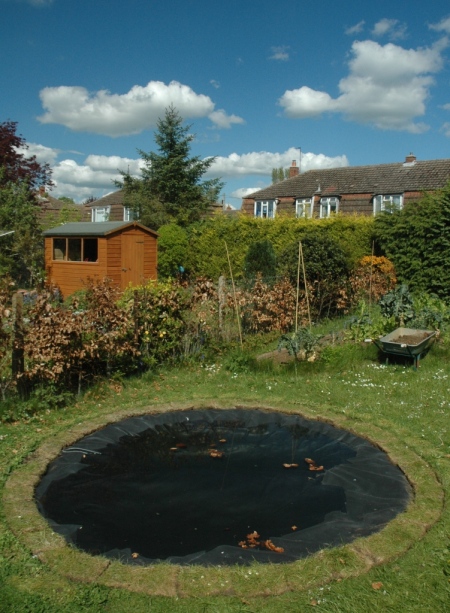
Two months almost to the day (this picture was taken on 27 April 2009) the pond is finished and ready for wildlife to find it.
Its still not quite full: the next day the rain came.
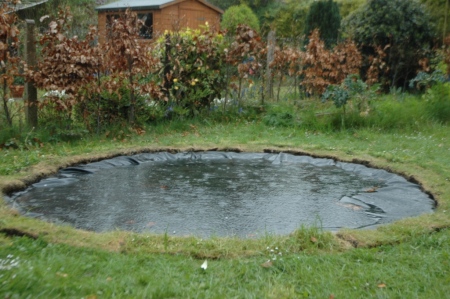
What’s next?
Well, we will add some plants to this pond: local, native, wild sourced plants (only collected from landowners who’ve given permission).
We won’t add ‘pond sludge’: the pond doesn’t need to be ‘started’. We’ve started it simply by making the hole and filling it with clean water, and anyway that sludge is quite likely a source of nutrients from someone elses pond that we don’t need.
We don’t want soil, or turves or fish food or any other of the pollution sources that commonly find their way into ponds. We will have more than enough just coming down in the rain (rain itself is slightly polluted these days).
We will put some clean children’s play sand on the bottom to make the pond a little more natural looking. This is chemically inert so no pollution problems, provided its clean.
And the wildlife? Well that started to arrive on day 1 with little flies laying their eggs, and on day 2 the first water beetles flew in.
May 2, 2009 at 9:56 am |
[…] The Garden Pond Blog Everything about making garden ponds for wildlife (and looking after them, too) « Pond Story: making a new clean water wildlife pond […]
May 2, 2009 at 11:46 am |
[…] 2nd May 2009: See the whole process fro mstart to finish of making a new clean water wildlife pond at Pond […]
May 8, 2009 at 7:56 am |
[…] A better shape is shown in the photo sequence for my new pond. […]
July 27, 2009 at 9:47 pm |
Just came across your blog – very useful as I have just started to dig a pond and was wondering about depth etc. Agree with you re depth, we have a tiny pond and after 2 weeks freeze only an inch or so frozen on top, but of course the deeper it is the warmer it will be at the bottom, maybe the frogs need +3C or something i.e more than just not freezing solid.
Also, I do not quite see what is so wrong with steep edges within the pond. So long as you have shallow areas & hedgehog-friendly margins, why are underwater cliffs so bad for wildlife?
However, what I really wanted to ask you about was the margins. I see you brought the liner up and out and then topped it round the edge with turves. But will these not die in dry weather? they have no depth of soil under them and will be like grass which creeps out over the pavement – fine in damp weather and the first casualties in dry spells?
February 19, 2010 at 11:10 pm |
What an excellent blog and an excellent website. Could you give us some information about suggested pond area though? Everything I’ve found pretty much says do what you want – but my garden is only about 11×3.5 metres, not including the patio outside the house and the shed at the far end. Obviously I don’t want the pond to take up the whole width of the garden or to otherwise dominate it. What’s the absolute minimum area – particularly the minimum width – that I could get away with to have a pond which is capable of supporting wildlife and won’t evaporate?
Also, I have a small apple tree by the shed at the end of the garden. If it weren’t for the tree, I’d say that the end would be the least intrusive place for the pond. But I’m concerned about roots piercing the pond lining, and I’m unsure how much the tree, which would be WNW of the pond, would block the available light. How much of an issue is this?
February 20, 2010 at 1:28 pm |
Hi Kieran – I’d say that 1m would be about the minimum; not because there’s anything magic about 1m but because any narrower and it would be hard to have anything except steep/vertical edges both sides.
But maybe a better bet would be to have say 2 x 1 m or 3 x 1 m with each square metre a different depth – say one with just 5-10cm depth, one 15 cm deep and one 25 cm max. Make them a bit uneven so they’re not all the same depth all the way through.
I’ve never seen a pond like this except in some experiments done to test pesticides but I think it could work.
In the south of the UK all ponds this size could dry out in a dry summer. To stop it drying out completely it would be good to connect it to the roof water, or a water butt filled from the roof.
Of course temporary ponds are a good, and special habitat, but I think if you’ve only got room for one pond they’re probably a bit difficult. There are no good ones in gardens so far.
As for the shade, my first pond has virtually no direct sunlight except for about a quarter of the pond in the middle of summer. The rest of the year it is shaded by 10 – 20 foot trees and a hedge. And that’s no problem.
I would try to avoid putting it right under the tree: I’m no tree specialist but it might not do the tree too much good if you have to chop a lot of it’s root, and they might be a problem for the liner (though I do wonder how often roots really penetrate intact liners).
Jeremy
February 20, 2010 at 2:16 pm
Hi Jeremy,
Thanks for that, it’s really useful :). I’m sure I’d be able to make the pond at least 1.5 x 3m so that’s just right.
I’ll have to think about your suggestion of connecting the pond directly to the water but/water drainage, but it brings up the question of flow control. Direct connection to the water drainage risks, I fear, either flooding the pond at times while not having enough water stored for the dry months. I imagine a direct connection to the water butt would require manual flow regulation with a tap? I don’t think it could be easily made to self-regulate.
Then there’s running piping along the length of the garden which, although probably not hard, is going to make the project considerably more complicated and expensive. I wonder also how much water the shed roof might provide.
As for the tree, I’ll have to look at how far its roots have grown. I suspect you’re right about the roots not finding a properly-sealed pond lining but I imagine the risk is even lower with a fibreglass pond mould. Unfortunately I’ve not been able to find any that match your design specs – I wonder whether there’s a niche in the market for selling shallow, gently-sloping fibreglass ponds!
Going back to water butts etc, how much of a problem do you get with mosquitos laying larva in yours? I have a burning hatred of mosquitos and don’t want to do anything to encourage them. I’ve been reassured by the kind people at Pond Conservation Advice that this shouldn’t be too much of a problem with a healthy pond that’s supporting enough predators to eat the things, but I remember as a child trying to chase the larvae in my parents’ water butt and I want to avoid the same thing happening. I wonder if the unit could be sealed, with some sort of one-way valve in the gutter pipe, to prevent the nasty things getting in to lay eggs?
February 20, 2010 at 3:21 pm |
Hi Kieran – yes i remember the discussion about mosquitos!
But I’d be surprised if you had much trouble with them even with a water butt (or butts).
There are larvae in ours butts but we rarely / never get bitten and the ones in the butts could anyway be a species that don’t bite people (I haven’t actually checked which ones they are). But some kind of seal might work.
In fact in our garden when we do get bitten its actually blackflies which come from a stream about 250 m away. I’ve never noticed being bitten by a mosquito out of doors.
To keep things simple in terms of pipes you can just store the roof water in a butt and not worry about connecting directly to the pond. A surprisingly large amount of water will simply fall into the pond from the sky and you can probably top up with a few bucket fulls of water whenever you feel its getting too low.
I did have my first pond connected to a water butt directly but after while it was clear I didn’t really need to worry too much about it – it stayed topped up as much as I wanted – in fact the only time we’ve topped it up in three years was for the TV! When they came to film it was a bit low looking – so we added water then, but otherwise it has remained amazingly full – perhaps becaue it is realtively shaded.
And you don’t need to keep it brimful all the time – going down to half depth in the summer isn’t likely to be a problem for wildlife – though it might not look great.
The most important thing is to make sure you stick to rainwater (assuming you’re in apart of the ocuntry where tap water is nutrient enriched).
Jeremy
March 2, 2010 at 5:18 pm |
The problem with shallow ponds is that in summer they dry out very quickly so in a reasonable sized pond you will quickly use up all your water from water butts. if you go on holiday for a week you can come back and find the pond a desert and all the wildlife dead or gone. This is particularly true if it has marginal plants. I will make my shallows a foot deep and put in some rocks to allow things to get in and out.
March 3, 2010 at 12:44 pm |
Hi David
In our old pond – which has a maximum depth of about 25-30 cm, we have added water only once since spring 2007. And we only did that because we had TV coming – that was last summer and the pond was still half full but we wanted it to look a bit nicer for the cameras!
Admitedly we have had wetter springs than usual but I think you would be very unlucky to have a pond dry out completely in one or even two weeks, if you started from fairly full.
Another problem is that people are commonly advised to put ponds in full sun where evaporation will obviously be greater. Our old pond is shadier and I think it goes down less quickly than our new pond, which is in full sun, because of this.
Having said that, our new pond which we made last spring did not dry out in the summer, which was pretty dry (see the Centre for Ecology and Hydrology’s monthly summaries of rainfall and water resources here: http://www.nerc-wallingford.ac.uk/ih/nrfa/monthly_summaries/archive.html).
Our new pond is also very shallow.
It’s also worth bearing in mind how many freshater plants and animals are adapted to periods of drying out – not fish, of course, but many things can comfortably survive low water levels and even complete drying out, by hiding away under logs, vegetation and so on. Other creatures can happily move on, and come back another time.
One thing that is still difficult – working out how to make the damp conditions typical of more natural ponds when you’re using a liner – I don’t think we’ve got the designs right for that yet as you probably need decaying wood, mats of grasses and so on to retain moist spots.
March 4, 2010 at 10:55 pm
An interesting point about decaying things and grasses etc. You say in your blog that the pond doesn’t need to be “started”. I take it the grasses would root in the sand you said you’d be putting in – have you done this now? Have you/did you cover the whole of the bottom of the pond with it? How thick? Has it stayed where you put it or has some of it just moved over to the lowest point in the pond? How effective was the sand?
I’m hoping to make a start on my pond next year – to be honest I’ve only just found out that I’m definitely returning to the UK at the end of this year – so I’ll let you know how it goes :).
June 3, 2010 at 10:19 am |
Hi
At long last I have posted you a rough drawing today of the ponds I had in mind, hopefully you can give me some ideas. My major problem, and no one else seems to have mentioned this, is that there is alot of cats coming into my garden, so I want to try and protect the wildlife as much as possible from the cats, any ideas? Plus what can I put into the shallow pond to hide the lining, if not pebbles/stones and what kind of earth/compost can I put in the bottom so that I can put the plants in directly?
All the best
Perry
June 6, 2010 at 10:31 am |
I would love to have wildlife pond but my garden is in full sun all day. There are no shaded areas. Would this be a problem?
June 6, 2010 at 10:56 am |
Hi Liz
No – it’s not a problem. In fact, the traditional advice is that ponds must be in full sun and it’s this traditional blanket advice that I’ve been disagreeing with.
Out in the wild there are ponds in everything from full sun to deep shade – and given the right management all can be good wildlife habitats (though in deep shade you’re probably not going to get your traditional lilies to grow).
Perhaps the most important thing is to make sure that you have enough clean water to last the summer – so you can do a bit of topping up to stop the pond drying our completely because the biggest problem will probably be the rate of evaporation – which is quite a bit quicker in the full sun. So work out where you’re going to get a good supply (and store) of rainwater first – I expect you’ve got a roof and this will provide all the water you’ll need if you can store it up over winter and then catch the summer downpours as well.
We’re still learning what the real issues are in full sun ponds: high temperatures may be one (we think the water temperature in our ‘sunny’ pond approached the lethal limit for our tadpoles in the recent warm weather, and it looks like it killed some of our water slaters too – and bigger swings in dissolved oxygen might be an issue as well.
But these are the details that we’re all still learning: fundamentally there’s no difficulty.
Jeremy
June 6, 2010 at 11:13 am |
Hi Jeremy, thanks for quick reply and so pleased that having no shade isn’t a problem. I had imagined that too much sun would mean pond covered in algae very quickly. We’ve just moved house and the back yard we’ve got hasn’t been a real garden for years. Have just finished clearing it and hadn’t really any concrete idea of how I wanted garded to go so have now decided to dig a pond and take it from there. As I’m away from home till beginning of August have covered garden over with membrane to keep weeds down. Will dig out pond when I get back home and I’m sure Scottish rain will fill it in no time. Will let you know how I get on. Very glad to have found your site. Thanks. Liz
June 6, 2010 at 11:36 am |
Hi Liz
Over-abundant algae is a sign of nutrient pollution – in gardens, usually from tapwater.
The sun doesn’t really have much to do with it – even though that’s what all the books say. It’s the nutrients – just think about all those Scottish lochs – out in the full sun, but barely a trace of filamentous algae – unless they’re polluted.
Jeremy
June 10, 2010 at 8:23 am |
Hi Jeremy
Yes please, any suggestions would be appreciated, thanks.
Perry
June 29, 2010 at 5:32 pm |
Hello Jeremy. I have just come across your very informative blog and I have a question for you. I created my pond about 5 weeks ago. It looks a lot like yours in size and shape and depth. I think it’s about maximum 30-40 cm at its deepest parts with shallow sloping sides. I filled it with rain water (we have an underground rainwater tank). I put in a layer of river sand. I plopped a few plants from the garden centre around the edges with no extra soil and they have rooted into the sand. I buried the liner around the edges and backfilled with subsoil to make boggy areas, taking care to ensure there no soil would run into the water (well maybe a tiny bit). Last week someone gave me some lillies from their pond which I submerged in the middle adding a bit of special pond compost. They are taking off well.
About 3 weeks ago, I fished some tadpoles from a local pond and put them in. They disappeared under the roots of a big iris and some rocks and logs. I did see one small frog two days ago swimming across the other side. All seems to be going very well: swallows and swifts are dipping and feeding over the pond, bees set up home in our chimney Saturday and they are constantly drinking at the pond, sighted a blue dragonfly, wasps drink regularly, and there are masses of birds having a ball.
We live north of Paris and we have been having some very hot weather, and the pond is in full sun so I have been concerned about the temperature of the water. It’ll be a while before the surrounding plants provide any shade.
When I put in the tadpoles in, I put in some algae for them to feed on. But now the pond is overwhelmed with the stuff. I go daily with a stick and twist it around picking up the algae like some green candy floss, but the next day there is just as much again. Is this algae harmful to the other plants (it seems to cling around their roots), or harmful to any other wildlife? Is it the hot temperature of the water that makes it proliferate? What can I do to regulate the quantity of algae? Would water snails help? I’ve also heard of barley straw…..
Sorry to be so long-winded but I wanted you to have the whole picture. I would appreciate any help you can give me. Thank you very much.
June 30, 2010 at 1:32 pm |
Green Algae
There is a lot written about Green Algae, so read websites etc for information…However….The most important ingredient to deal with algae is patience and trust. I have had it in all ponds created from new for the last 25+ years and I expect to see it, but do not despair!
You can pull it out with a stick or rake but I have 100 percent success by leaving the pond alone, no chemicals, no pulling out, no nothing. Just leave alone, it may increase but eventually it dies back of its own accord, goes brown, sinks to the bottom and decomposes as an aquatic soil at the bottom of the pond. Yes it does temporarily imbalance the oxygen levels in the pond, it does look unsightly for a time, but trust in being patient. Least interferience, equals best long term result. Barley straw is only for the pea green water problems.
It does help to have a deep water area in the pond, say 80- 120cm’s, to help prevent drying out, and maintain oxygen levels, but it is perfectly acceptable for ponds to be seasonal and dry out too. Hope this helps. Apologies to Jeremy to whom the query was targetted…didn’t want to interfere!
June 30, 2010 at 1:46 pm |
Hi Martin – Don’t worry – I’m very pleased to receive your comments.
Jeremy
June 30, 2010 at 5:35 pm |
Thank you, Martin.
Leave it alone, huh? Sounds like my kind of gardening!
July 18, 2010 at 9:30 am |
Have been building a small wildlife pond in my garden..roughly 2m x 1.5m. Read lots of info on the web, but this blog was really helpful in designing it, ie I have plenty of shallow areas, and max depth is no more than about 45cm. Have built trenches all around the edges, to prevent run off where I shall plant waterside flowers and grasses seed, and there will be a small bog garden about a foot from the pond.
Filled it yesterday with tap water. I know that’s not the best but I really can’t wait for the rain, living in south east London. But I’ve just bought a water butt which I’ll be able to use in future in topping up.
So far just chucked in little amounts of hornwort, starwort and frog’s bit bought from,
http://www.naturescape.co.uk/ (all their stuff has 100% British provenance)
I have a couple of water sedges I’ll put in it which I’d grown in my sunken aquarium for a couple of years, obtained from the local London Wildlife Trust pond. There’ll be planted in London clay/sand in baskets which I got from digging 2foot down in another part of the garden.
Within 4 hours off filling it yesterday, a pond skater had turned up. Not bad for a small garden pond in Peckham.
Shall write a fuller account of the whole project, which I’ll link to here.
Thanks Jeremy, your blog was really useful in planning it, even though I’ve used tap water initially. I know its not ideal but I don’t feel able to do absolutely everything according to nature, and there’ll certainly be no run-off from rest of garden because of the trenches I’ve dug all around.
July 18, 2010 at 10:36 am |
Hi GiddyGedy
It’ll be really interesting to hear how you get on. Do keep me posted!
Jeremy
July 27, 2010 at 10:51 pm |
Hi Jeremy
Very interesting blogs here – I am in the process of overseeing my friend’s new pond. I had two previous very successful ponds in Essex. Now live in south of Ireland in Co Cork. I used builder’s dpm for both previous ponds and as long as it isnt exposed to light, there were no problems at all. We had newts, frogs and toads as well as all the flying insects attracted to the oasis. I was very upset when my former next door neighbour told me the people who bought my house had filled in the pond!! I am going to make a pond in my own garden this year as there are none in the vicinity – a slow flowing river is a stone’s throw from my garden and I miss frogs and news and watching the birds taking a bath in the shallows.
July 27, 2010 at 11:03 pm |
Hi Mary – I’ll be interested to hear how you get on. If there’s any advice I can give, let me know. Jeremy
August 25, 2010 at 6:16 pm |
Hi Jeremy. It’s about 6 weeks now since I filled my pond..as I said with tap water. It hadn’t rained since and I decided never to add tap water again. The level went down to nearly 50% I think. Anyway in the past week we’ve finally had plenty of rain here in south east London and the pond is really quite full again.
The pondskaters didn’t hang around for very long, and about 2 or 3 weeks ago I got the predictable algal bloom and masses of midge larvae. I also saw a very tiny green water boatman swimming across the pond to a rock and then it took off.
So not a huge amount to report in terms of much biodiversity of invertebrates as of yet….but I would expect that, especially living in an area with few ponds around. But I have a fox who comes to drink every evening, sparrows bathing and drinking and one evening at dusk a pipistrelle bat spent ages just darting around above the pond; I think a lot of midge larvae may have ben emerging?? I’ve never had a bat before in my garden so it’d be quite a co-incidence if it wasn’t connected to the pond.
I’ve sown meadow grasses around the edges on the liner with a mixture of sand and subsoil as a medium. The frogbit I put in took a bit of a battering from the voracious midge larvae, as did the hornwort and starwort. But they are hanging on fine and the number of larvae has gone right down now.
I’m hoping the pond water is fairly unpolluted with XS nutrients because the pond sedge is still pretty stunted compared to some I had in a bucket with ordinary soil and water.
Anyhow it’s rain water all the way for me now, even if it dries up altogether next summer and the water butts can’t entirely cope.
One thing I wanted to ask. The pond is fairly near a high hedge with a great mixture of plants and there is hawthorn tree a few metres away so I’ll probably get a fair few leaves, berries and twigs in the pond later. Should I remove any? I was thinking to just remove some if it gets really snowed under.
I really enjoy reading your blog.
August 26, 2010 at 8:18 am |
Hi Flying Ants
Good to hear about your progress.
Re the leaves: I’ve got a big hedge down one side of my old pond and I get quite a lot of leaves and twigs in the water on this side of the pond.
So far they’re doing what I expected – providing a different habitat, and often a place which seems attractive to my Large Red Damselfly larvae, and also to the larvae of Broad-bodied Chasers.
I don’t really know if this is cause and effect but certainly if I want to find something different or extra to what I can see in other, less shady, parts of the pond – this is the place I look in.
Jeremy
October 2, 2010 at 1:43 pm |
I have just finished my little pond. I can’t wait till little critters start turning up. 😀
http://www.wildaboutbritain.co.uk/forums/water-life-forums/76650-pics-my-new-wildlife-pond.html
Thanks for the info on this blog, it really helped steer me in the right direction.
October 3, 2010 at 9:27 am |
Good to know that you’re finding it useful.
Jeremy
October 4, 2010 at 9:29 pm |
It’s now 2 and 1/2 months since I built my pond. Had very heavy rain a couple of days ago and its filled up considerably again. I’ve seen a backswimmer on and off for the last 2 or 3 weeks, which seems to feed on the midge larvae. I was amazed on one occasion to see it ‘pounce’ so quickly on something it almost seemed to jump out of the water at it. I love it. And today I saw my first water beetle. I saw it for about a second as it dived down to under a pebble..but what an exciting second it was.
I’m thinking that because I live in inner city south east London it might take a bit longer for stuff to get to my pond..but it’ll be interesting to see what happens next year. I get a bit jealous reading on the web about all the things that seem to turn up in no time in ponds in more rural areas. But hey its an exciting project, and I’m doing my bit to help the inner city pond critters.
Thanks for your advice about leaves Jeremy..I’ll let nature take its course unless an unexpected vast amount of leaves enter the pond.
Can you recommend a good book for identification of species of freshwater invertebrates?
November 22, 2010 at 11:22 am |
I watched Autumn Watch Unsprung over the weekend on iPlayer. They had some frogs on..and Kate Humble made that same old point, that if you build a pond make sure at least some of it is a metre deep so that frogs van hide down there over the winter in case the pond freezes..she then sort of mumbled something about..oh well at least have some shallows as well. But anyone watching the programme would have got the main message about having some a metre deep.
Autumn Watch is a hugely influential programme, and Kate Humble is a very well known person in RSPB. For goodness sakes can’t such people be told to give *facts* and not myths. I can imagine many ponds being built now with great deep bits in them..with little thought for shallows.
March 4, 2011 at 10:40 am |
Hi Jeremy, I dug my pond out last summer and it’s been fine since then with the water staying nice and clear…until yesterday! Overnight about half of the pond has now got a kind of a film/skim of something over it. If you touch it bubbles develop and just stay there. It just seems to be lying on the surface of the water. Any ideas of how to clear it or what it could be?
March 4, 2011 at 12:43 pm |
Hi Liz
Could you send a photo or two?
Jeremy
March 5, 2011 at 10:43 am
Hi Jeremy,
My husband is working in the Sudan for the next six weeks and he has our camera with him so unfortunately I won’t be able to send you photos. I did take some on my mobile but the quality wasn’t great. The skim is almost translucent. It does look as if something has been added to the pond but I can’t think what it could be or how it got there. We’re having heavy rain here today so maybe that will help. I’ll let you know what happens.
Liz
March 6, 2011 at 6:08 am
Hi Liz – oils and films appearing on water when there’s an obvious source of pollution are usually natural bacterial or algal films and, though it’s hard to be certain, will probably turn out to be harmless.
Jeremy
April 3, 2011 at 4:25 pm |
Hi Jeremy i put in a pre formed plastic pond last year as a wild life pond and in the autum the water ended up stinking from what i think was the amount of leaves in it which fall from a nearby huge oak tree, so had to empty and fill with tap water and make sure not to many leaves fall in was up there every day with a net to remove them. Anyway havent had any frog spawn yet so one day when i was out walking the dog i went past a local natruel wildlife pond which always dries out in the summer but seemed to be drying out already with little puddles with spawn and tadpoles in which were surely going to die in no time so i went back with a tin and took them for my pond where they seem to be doing fine i even spotted a fully grown newt in there yesterday, my question is was what i did ok for my pond and also having used tap water will this be a problem forever in my pond or will the negatives of tap water go over time, i also introduced some snails i collected they are quite strange two pence coin shaped and size will these be ok
April 18, 2011 at 11:07 pm |
Hi, Jeremy (and everyone else). My pond is into its third year. It was filled with tap water and within 24 hours of filling, there were insects swimming around under the surface. The first year it went green with algae and then went brown. This year, it tried to go green with huge whisps of algae, but I twisted it out with a garden tine rake and so far the water’s stayed remarkably clean. I have a great diving beetle that looks like a small turtle, and some of the same species’ evil looking larvae. (Boy are they wicked things or what?) Also got waterboatmen of various sizes, and one damsel fly last year. Starlings and sparrows bath at the shallow end. Sorry, no educational information here, I just love talking about it.
May 12, 2011 at 8:15 pm |
Hi Jeremy, I live in Abingdon and have a small front and back garden – do I have any chance of fitting in a pond that would work sustainably? The place I have most space is in the front garden, but it’s by a public footpath…
May 13, 2011 at 9:16 am |
I know at least one small nice pond in a front garden in Abingdon so it’s quite do-able. I could put you in contact with the owner if that would help – I’m sure she wouldn’t mind showing you the pond.
Jeremy
May 17, 2011 at 7:35 pm
That would be great – I’ll e-mail you my contact details to Pond Conservation. Many thanks, Dalibor
June 27, 2011 at 10:08 pm |
Dear Jeremy
Something important you did not mention or do when you built your pond, & many book & web sites do not mention it either: put an old carpet OVER the liner as well as one underneath. This is to:
a) hide the unnatural-looking rubber;
b) protect the liner from UV light, cats’ claws, etc;
c) give small plants something to root into;
d) allow algae to grow & make a natural-looking lining.
Pamela Simpson
June 28, 2011 at 10:17 am |
Hi Pamela
Sounds like a good idea – making a natural base over butyl seems to me a challenge we haven’t quite sussed yet.
My only worry might be (I’ve no evidence) nasties in the carpet. But I don’t know what carpet is made of.
Jeremy
July 3, 2011 at 10:29 pm |
Hi Jeremy,
I’m currently in the planning stages of a wildlife pond for my garden and came across your blog, which is full of very helpful advice and information. I’d love to see a photo of what your pond looks like now, two years on.
July 4, 2011 at 1:24 pm |
The carpet has to be made of ‘natural materials’ as this sort of material is often used as a ‘mulch’ on gardening plots for example – the natural fibres will eventually bio-degrade under a mulch – while the chemicals found in synthetic fibres would possibly leech out into any water –
Not sure how much carpet is actually ‘natural’ fibre nowadays – The preservatives, and other treatments in the carpet may be a worry.
I am planning a new pond at my allotment where I am going to create a larger version of my garden pond – I may try carpet or hessiah sacking under the sand or washed gravel.
March 3, 2012 at 3:08 pm |
We are just in the early stages of planning our wildlife pond, only going to be small, but love all he ideas here. I would also love to see a photograph of your pond as it is now. That would be brilliant.
March 14, 2012 at 4:41 pm |
Hi Jeremy, we have just made a garden pond, (last week) and have not added any subsoil of any kind, so hope the planting of things willbe successful. It would be lovely to see your pond in further stages, from the ones above. Any chance of you putting new pictures up, so that we can all be encouraged by your progress?
March 20, 2012 at 3:08 pm |
HI,
We just built a pond – it doesnt get a lot of sun and it has only been filled with water for about 6 weeks. It is already looking a bit murky (which I dont mind) but people keep commenting that I need movement in the water (waterfall or feature) or a pump or it will get stagnant. Is this true? I dont know what to do _ dont want it to be smelly and stagnant but I dont want to run electricity to it either.
March 28, 2012 at 10:20 pm |
Great to see such info in one place! I have a boggy area in the corner of a paddock and a rill running across it to an old well on the other side of the paddock. Puddling in left a great deal of grass growing up through. A liner just floated up as there is a spring in the neighbouring field feeding my boggy bit. I have made a shape, about 5m by 4m which has filled nicely, had newts etc. last year, but the grass is impossible (for me) to pull out completely so it has taken over. Any suggestions other than putting a preformed pond on top of the lot, which doesn’t seem very ‘wildlife’. Advice would be really appreciated.
April 17, 2012 at 2:14 pm |
Hello Pat, sorry I missed your post earlier, i hope some of the “experts” can give you advice, I am a new pond owner, so cannot really advise, other than the pre-formed ponds seem to be fairly deep and do not have graduated edges, which the wildlife seems to prefer. We have one very small preformed pond, which is nearly 2 years old, had frogs in last summer but nothing since. Our newly built pond (using liners) is more graduated depth wise and will, hopefully, be better for any frogs/toads/newts that visit next spring.
Sorry I cannot be of more help though. I do hope you get response from lots of the posters who were about here last year, but seem to have disappeared now.
April 5, 2012 at 6:26 pm |
Hi Rachel, we have had one small pond for nearly 2 years, no pumps or electric in that, it was a bit murky to start off with, but once the oxygenating plants start working, I am sure yours will clear. You will probably get some sort of algae in there,but get a long cane and put a nail in the end, then just twirl it amongst the algae and it should be easy to remove.
We have also just started off another larger pond (see questions above). Still awaiting some answers, but ours is now getting a bit green in parts, the algae is attaching itself to the plants and planters, but we got some ramshorn snails from the aquatic centre, These should help to control algae too. If you are wanting to keep your pond purely as a wildlife pond, then it should be great to leave without any water movement. I think it is only people with fish, that need some sort of fountain/water movement.
April 10, 2012 at 9:08 am |
Hi Elaine,
Thanks so much for your reply. We have loads of tadpoles in it now and we will put in some more plants when the weather is a bit warmer soon. Thanks again for the information.
April 10, 2012 at 6:25 pm |
Wow, I envy you your tadpoles, did you put the spawn in yourselves, or did the frogs find it. We have not had any spawn. All we put in was oxygenating plants, an iris and junca something or other. We did put some oxygenating grassy plant in, but the birds kept taking it all out to use for their nests, so we put those in water and kept it in the greenhouse until the birds have finished. We will buy some more plants in May.
Keep us informed as to your progress. (we seem to be the only two active participants here). Hope we get others soon, as it is good to compare notes. 🙂
April 12, 2012 at 12:17 pm |
Well we walk our dog up the back of a small mountain sometimes and we noted a small pond had appeared but as the days went by it was getting drier and drier until it was a tiny puddle (with tractor wheel marks throught it!) and there was a clump of frog spawn in it which looked a bit worse for wear. Also a number of dead frogs. So we scooped up the bit of frog spawn and dumped it in our pond, didnt think it would do well but now there are thousands of tiny tadpoles! When we went back a few days later the puddle had gone. I dont know if the tadpoles will all survive but if they do we will have an infestation!
April 12, 2012 at 4:54 pm |
Hi Rachel, that is good and I hope all your tadpoles survive. I was feeling very envious of your frogspawn, with it being a new pond. I would have done the same thing too, rescuing the spawn. So exciting to hear. Has your pond still got green algae in? Ours has, but hope it clears soon. Fortunately we have had some rain recently and it has topped it up nicely. Good luck with yours, hope we can keep in touch and compare notes. x
August 29, 2014 at 9:02 pm |
I’ve just had a new wildlife pond built. Unfortunately it was built by contractors who needed to get it done so I couldn’t wait for enough rainwater to fill it. They needed it full so they could see the levels and deal with the edges. As we were re-siting the existing wildlife pond I managed to save some of the water but the new one is probably twice the size so unfortunately tap water has been added. Reading other advice on the internet we have also put two shovels of topsoil into the middle ….. as instructed! Damn. I only found this blog today!!! Do you think I should try and remove that topsoil in the deeper bit? And what should I use in the planting baskets? The water weed is mostly loose in the new pond except for a few bunches weighted down into the depths. I’m going to try and turf up to the edge. The contractors were bringing rocks but are now bringing more turves instead. I must say I am certain they think I am completely mad!
We had to re-site the old pond as we had massive troubles with a Portuguese Laurel dropping leaves and red berries into the pond and it had also silted up in the deep part probably about 30cm. The Hornwort and some other pond plants were taking over and what was once a pond resembled a bog garden. The native white lily was rampant but had stopped flowering as it had grown too far out of the water, I think. Although I must say we had very little blanket weed and algae problems. It just looked incredibly unsightly and the water did smell a bit, although reasonably clear. We were getting 6 or so frogs spawning each spring. Only one male frog was there when we filled in the old pond. I’m hoping he will return to the new one, fingers crossed!
Re-siting the pond has been a NIGHTMARE. The contractors were exasperated with me as I tried to save every single critter! Does anyone know how long I should wait before I add all the pond snails I have saved? Some other critters such as newts and dragonfly larvae are already in. I figured the newts would crawl out if they weren’t happy! Any advice appreciated as I cannot find any help for RE-SITING an existing pond. I have felt like a killer as obviously I could not get every single critter out ………..
August 29, 2014 at 11:08 pm |
Hi, how big and how deep is your pond?
August 29, 2014 at 11:52 pm |
Having created ponds for the last 20 plus years, it frustrates me to hear people being so precious about what to do. Yes you have made mistakes but that is all in the past and there is no point going over them. Accept where you are now with the pond. Chuck in all that you want to now apart from material that will challenge the BOD (oxygen demand) and leave the pond alone, including the soil. leave it for an unbelievable 2-3 years,; do not add chemicals and clear any duckweed should it arrive. Just leave alone, no tap water…nothing… and let nature take its course. If the pond goes green put some barley straw in a net and float in the water for a few weeks until the water starts to clear, and reduce over zealous plants by cutting back in late winter as necessary…but that’s all!! In 2-3 years you’ll have a great pond. Enjoy!!!
August 29, 2014 at 11:25 pm |
We dug our pond out back in 2010 and it has taken until this year to be a pond full of life. Now having introduced frog spawn back in March have had a great time watching the spawn develop into taddies and now have baby frogs in all different sizes…they are all so very cute. We used to have a terrible problem with blanket week but at the beginning of this year bought a cheapish solar pump from Ebay and it has worked a treat. Now have a much clearer pond and have been able to enjoy watching the taddies and then baby frogs. Who need s a tv when you have a pond to watch?